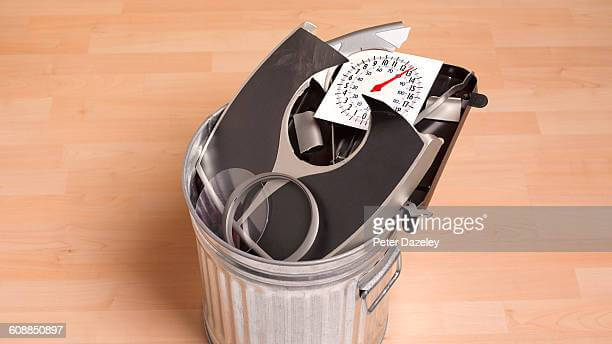You’ve been going to the gym for a week straight now, getting a hard sweat going, being absolutely determined to lose the weight this time around!
There’s no way you didn’t lose weight, you’re working harder than you’ve ever worked before.
You step on the scale at the end of the week to see all the progress that you’ve made, to finally see how all your hard work has paid off.
You put the scale on your bathroom floor. Hop onto it while staring between your feet just waiting for the digital numbers that’ll decide your fate.
No change.
Suddenly you’re overcome with a whirlwind of emotions…
You’re confused – how did you not lose weight after all the work you put in?
You’re angry – the scale must be broken! There’s no way that it’s right!
You’re frustrated – why put in all this work if you’re not going to make any progress?!
The truth is, you have made progress, you’re just not measuring the right things!
When it comes to weight loss it’s easy to get caught up on how much you weigh – because that’s what you think you’re trying to change.
However, the scale can be deceptive which can have you lose sight of the most important measurables.
Why You Can’t Trust The Scale
Sounds weird to say because you’re trying to get slimmer so that means you’re going to lose weight right?
Well, yes and no.
There are so many things that can influence your weight on a day to day basis:
- Being Sore: When you’re sore your body tends to retain more water which causes the scale to go up.
- Having a Full Bowel: If your stomach is full or you haven’t gone to the bathroom you’re going to weigh more.
- Having Extra Carbs: Every gram of Carbs you consume retains about 3-4 grams of water.
- Consuming Excess Sodium: This can lead to water retention and an increase in weight.
- Being Stressed: Having elevated cortisol levels also causes you to retain water.
- Drinking Alcohol: This can have an effect on your scale weight for 4-6 days!
- Menstruating: Being on your cycle has adverse effects on your weight.
If you weigh yourself on a daily basis you’re going to see the scale fluctuate up and down. This doesn’t mean you’re doing everything wrong, there are just many factors that influence your weight!
It’s important to realize you’re not trying to lose weight – you’re trying to lose fat!
You’re trying to be slimmer, feel more confident in yourself, and fit in those old clothes that you still like but haven’t been able to wear!
The scale won’t tell you how much fat you’ve lost, it’s only going to tell you how much you weigh at a particular moment. Instead of worrying about what the scale has to say, let’s focus on some other markers of progress that will tell us how we’re actually progressing.
How To Measure Physical Progress
Here are a few ways that you can measure your progress in a way that will accurately tell you how your body is actually changing!
Progress Pictures
The goal of any transformation is to change your body. You want to shed some fat off your body and tone up as well. What better way to actually see that progress than with a side by side comparison of what your body looks like from month to month!
For progress pictures, I recommend you take a front profile, side profile, and back profile of yourself in swimsuit attire. You want to try and keep arms away from your side so you can get a good picture (haha pun) of what’s going on – like so:
I would suggest taking these once every 4-5 weeks so you can see how your body changes on a monthly basis.
Tape Measurements
For you to actually know if you’re losing inches you need to measure how many inches are there in the first place!
We want to measure specific parts of our body that will accurately outline the biggest changes across your entire body. Here’s an image to illustrate what that might look like.
The parts that are defined are as follows:
Chest: Measure across your nipple line and with your arms down to your side
Arms: Measure across your bicep and tricep peak (the thickest part of your arm)
Waist: Measure 2 finger-widths above your navel
Abdominals: Mesure 2 finger-widths below your navel
Hips: Measure the thickest parts of your glutes
Thighs: With your arms to your side, measure the part of your thigh where your fingertips end
An important thing to remember here is that you need to measure the same spot from month to month. If you’re moving up and down your thigh you’re going to have wild fluctuations that aren’t accurate.
You can either use your hands as length markers as mentioned, or you can some other landmark on your body for reference. Maybe you have a birth mark, scar, or tattoo that you can measure over every month!
The idea is to be as consistent with your measurements as possible so that you can accurately and honestly gauge how much your body changes in size across the board.
The Scale
“Wait, what?! I thought you just said the scale wasn’t reliable? What gives?!”
Well, it’s true, you can’t rely on the scale to give you results on a day to day basis because it won’t accurately reflect how much fat you lose or how much muscle you gain.
However, we can use the scale to accurately measure the general trend of your body weight!
Instead of focusing on daily fluctuations, we’re going to focus on week to week averages
You’re still going to weigh yourself 3-7x per week but instead of comparing it with the day before, you’re going to average it for the week so you can compare it with the week before.
This way it accounts for fluctuations that happen from day to day life to show you the true direction that your weight is headed!
Bio Feedback
This is one of the most overlooked aspects of measuring progress in my opinion.
Measuring Bio Feedback is mostly subjective, meaning you’ll grade yourself on how you feel, but it’s an important part of making sure your hormones are in check and your health is still on point while you’re trying to lose weight.
You’ll be gauging different health factors on a scale of 1-10, such as:
- Training performance
- Recovery
- Sleep quality
- Appetite
- Cravings
- Stress
- Energy Levels
- Mood
Your body uses all of these different variables to communicate with you. If all of these are positive then you’re treating your body right, but if they’re negative then you’re either lacking or overdoing it somewhere in your diet and lifestyle.
Conclusion
The number on the scale is the most talked about phenomenon in the entire fitness industry. Everybody wants to talk about their goal weight, how much they lost, where they were happiest, and how they got there.
That number doesn’t tell the whole story, it doesn’t paint an accurate picture of who you are, what your struggle has been and what you’ve gone through!
You are so much more than just a number on a scale and I hope you recognize that.
Need help improving your physical progress? Click Here to schedule a free strategy call so we can get you pointed in the right direction!







